It looks green, charming and even unspoilt, although it is a frequently visited tourist destination in the state of Sikkim. It is located in a peaceful, cozy surrounding covered by high hills and lush green forest. This small, but beautiful village doesn’t look like a growing centre of urbanisation, yet it has some decent facilities like hotels, restaurants, tour agencies etc. It’s the entry point for Kanchenjungha National Park and thus regularly visited by the trekkers and mountaineers from all around the world. In fact, many people think that the number of Indian visitors are far less than the foreign visitors.
If you don’t know about the history of Sikkim, you may find it like any other beautiful village in the mountainous regions. But, Yuksom, the birth-place of Sikkim, is much more than a tourist destination. Its contribution in the history of Sikkim is very significant. It was the first capital of Sikkim way back in the 17th century.
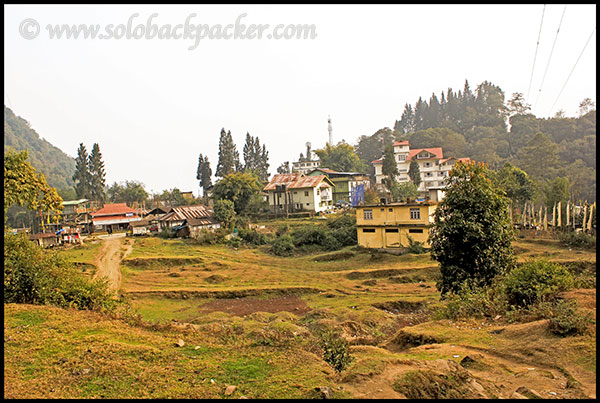
Although Yuksom has a motorable road and reaching there is not a difficult task, but in the off-season for the tourists, we experienced a great difficulty to reach there using public transports from Ravangala, another beautiful town of South Sikkim. There wasn’t any concrete and sure shot information about the availability of the shared jeeps, so we became confused by many suggestions. We started at 0730 AM from Ravangala and reached Yuksom at 0415 PM after spending almost 9 hours for a 3-hours journey. It’s not because the lack of transportation, but it was because, in the absence of correct information, the things didn’t turn out as planned. We had to wait for 2 hours at one jeep stand and 3 hours at another jeep stand, because the shared jeeps don’t move unless they have the booking for all 10 seats. At one point, we even thought, that we might not be able to reach Yuksom by the evening. However, later on, we managed everything conveniently and reached Yuksom comfortably. The transport system is complicated, but with the right information, it’s easy to move around. (Read here: How to travel around in Sikkim using public transport).
The first sight of Yuksom was very refreshing. We already had a booking for two nights at Limboo Homestay in Yuksom, so at least, we didn’t have any tension on the accommodation part. Luckily, the homestay was nearby and the jeep driver dropped us at his last stop, in front of our homestay.

There was no chance to explore the village on that evening. We decided to take rest at the homestay only. However, it provided us sufficient time to interact with the owner of our homestay. Mr.D.S.Limboo is a very nice person with a down-to-earth nature. Few years ago, he was very active with the trekkers group in the area as a tour operator, but now, he handed over all trekking activities to his cousins and maintain this homestay at Yuksom. He also works as a school teacher in a nearby school.
We sit around the fireplace and talked about the life at this remote hamlet in India. We had discussion about local people, cultures, traditions and he also gave a lot of idea about the trekking routes in that area. He informed us about his visits to Bhutan, about an animal Dzo, that is the cross of Cow and Yak in the Himalayan region and many other aspects of village life. We talked about the sustainable tourism at Yuksom and how it emerged as a birdwatcher’s paradise in the last couple of years. Her daughter took us to nearby fisheries center, where our daughter enjoyed the sight of a large number of fishes.
We were not sure about what to do in Yuksom, because we just intended to spend a couple of peaceful days in the lap of nature. Mr. Limboo gave an idea about some places to enjoy on the next day. Thus, we decided to explore Dubdi Monastery, Kathog Lake and Coronation Throne on the next day.
Trek To Dubdi Monastery: About one and half km away from the Yuksom village, Dubdi Monastery is situated at the height of 2100 meters on the top of a hill. The hiking trail to the monastery starts from a government dispensary in front of the Limboo Homestay. The ascent is gradual and dotted by several water driven prayer wheels inside the small huts. The forest cover also increases gradually, initially the cardamom plantation and then the dense wild forest of Rhododendron and Oak Trees beyond a river stream. After walking for 400-500 meters, the gradual ascent becomes a steep one consisting some steep flights of stairs through a dense forest.
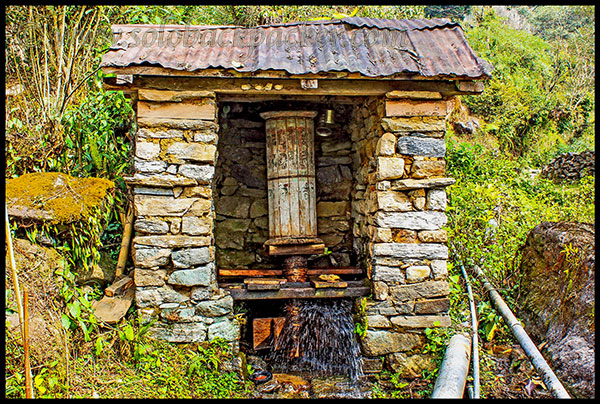

After one or two flight of stairs, our daughter surrendered herself in the lap of her mother. She was too young to walk on that trail. The hike seemed very tough after holding her in the lap, but there were small sheds at every 100 meters to take some rest.
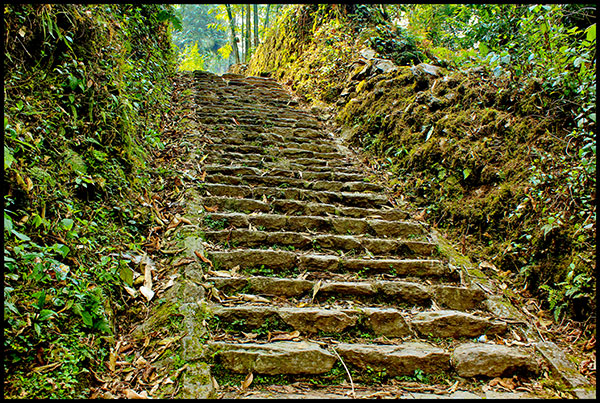
Anyhow, we crossed the forest trail and reached to a non-paved road going towards the other villages in the region. Another steep hiking trail starts from the other side of the road and a sign board indicates that the monastery is only 312 meters away from there.
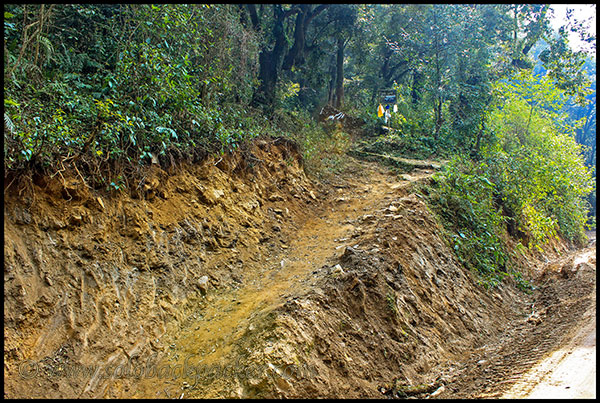
We already heard in the village that a road goes upto the monastery and people use that to reach there by a vehicle. Under that impression and to our bad luck, we moved ahead on that road, because there was no ascent on the road as compare to the hiking trail. The surrounding valley appeared very beautiful and we forgot all the tiredness, while walking on the road.
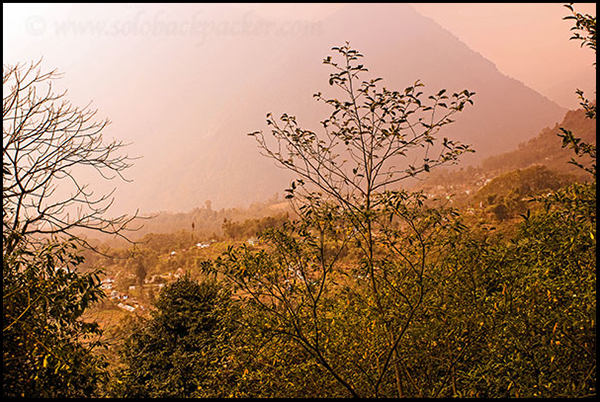
After walking for about 20 minutes, we realized that the road is almost parallel to the hill, while monastery is at the top. There should be some ascent to reach the monastery. With the doubt, we moved for few more minutes and reached at the other side of the hill. 2-3 villages were visible from there, but there was no sign of a road going to the monastery.
Luckily, mobile connectivity is good in this region, so, I called Mr. Limboo for the right direction. He informed, that the 312 meters sign board is the correct point, and there is no alternate to reach the monastery. The people, who travel by a vehicle, leave the vehicle there only and continue on that hiking trail to reach the monastery. Since the road was almost parallel, we returned back to that point comfortably. After 30 minutes of more effort, we ascended on a steep hiking trail and reached to the monastery.

Dubdi Monastery: Dubdi Monastery is the first Buddhist Monastery in Sikkim, established way back in 1701 by the Chogyar Namgyal. The monastery has nothing special to explore, yet being the first monastery of Sikkim is a pride to cherish. The small monastery houses some rare and beautiful paintings, however photography is not allowed inside. Some rare manuscripts on Buddhism are also preserved in a hall. The monastery is clean and well-maintained, but the recent earthquake in Nepal region slightly damaged its outer structure. There are some large cracks in the outer wall to explain the extent of damage. The repair and restoration work is going on at the monastery and it is expected to cover those cracks very soon.
Every visitor needs to buy an entry ticket of Rs. 20 and photography is not allowed inside the monastery. The monastery is normally inhabited by two monks, who take care the whole monastery as well as the entry fee. They travel to Yuksom regularly in a day or in two days to cover their daily needs.
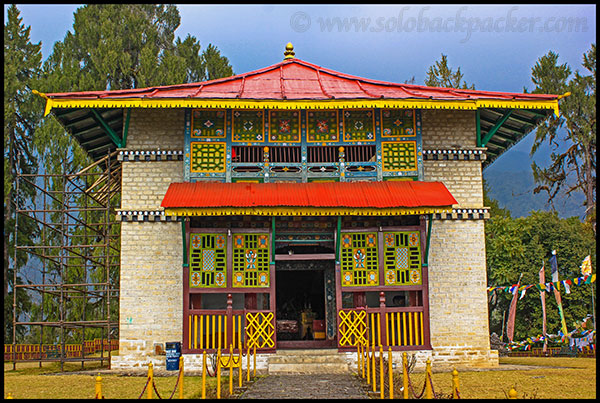
The descend from the monastery was quite comfortable. When we reached to the non-paved road during our descend, we left the trail and walked down on the road. Yuksom is only one km away by the trail, but it is about 3 kms away by that road. We enjoyed the view of surrounding atmosphere, cardamom plantation, local people working in their fields.
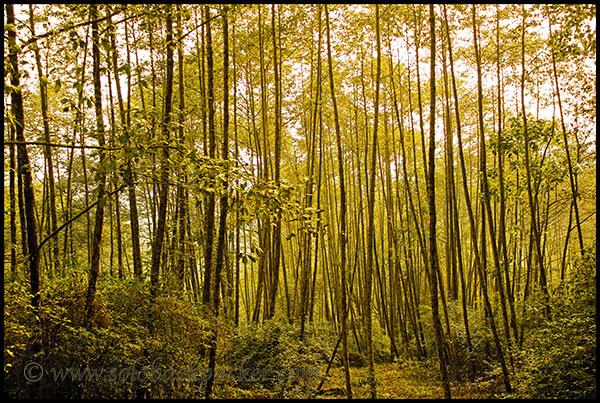
Kathog Lake: Slowly, we reached to the Kathog Lake, but the whole area was closed and the main gate was locked. The lake appears very small from the main road, and I sneaked in through the trees to take a picture of this lake. The lake is a small one, but considered as very sacred among the local people. It is believed that the great lama sprinkled the holy water from this lake on the coronation throne of Norbugang during the crowing ceremony.

From there, we went to the main market of Yuksom village, near the new monastery. There were lot of restaurants along the main road in Yuksom, but since it was an off-season, most of them were closed. We found an open restaurant and had our lunch there.
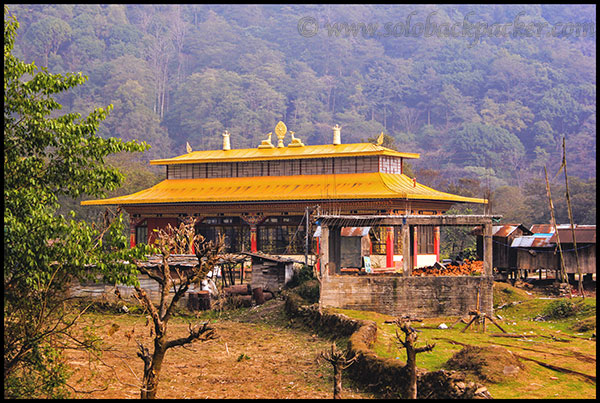
After feeding our hungry tummy with some delicious food, we were ready to move again. Our next stop was The Coronation Throne of Norbugang.
The road to the coronation throne is a motorable road and you can hire a vehicle from the small market. We decided to walk, as it was only about one km away. The ascent to the throne is not that much tough, but the road is full of loose stones and the walk became slightly painful, especially when we were tired due to our trek to the Dubdi Monastery.

The Coronation Throne: We reached to a ticket counter outside the coronation throne. The entry ticket fee is Rs. 20, but nobody was there to sell the tickets. We didn’t find anyone to ask, and entered inside the premises. The premises consists a buddhist temple, a stupa (not very attractive, but it is believed that it contains the water and soil from all over the Sikkim) and the seats of the great lamas under a huge pine tree.
The legend says that when the struggle between two sects of Buddhism increased in Tibet, the great lama Lutsum Chembo moved southwards from Tibet to find a peaceful place to establish a Buddhist Monarchy. In the hidden country of Denjong (the valley of rice, modern-day Sikkim), he arrived at a place known as Norbugang. There, he met two other great lamas Sempa Chembo and Rinzing Chembo. The three holy men searched for a monarch to rule the land and thus the great Phunstok was crowned as the first Chogyal (King) of Sikkim.
Yuksom literally means the meeting place of the three great lamas. The stone throne on which the coronation took place can still be seen under the huge pine tree. The three other stones are also there, where the name of three great lamas are clearly erected.

When we returned back to the homestay after our day-long walk around Yuksom, it was completely dark. Our next destination was Darjeeling on the next day, but for that we were supposed to reserve our seats in advance on a shared jeep. Mr. Limboo quickly helped us and called the driver to reserve the seats for us.
I normally don’t recommend a place to stay, because different people has different level of comforts in the same hotel. If I say that one hotel is very good in my budget, it may not be a nice place for other people with different budget or different expectations. So, I normally avoid such type of recommendations. But, if you expect to visit Yuksom in the future, try to stay at Limboo Homestay. That is a very nice place offering a great level of hospitality. The people behind that property have the beautiful hearts to provide you a memory of lifetime.


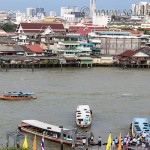

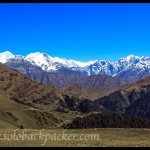



Hi, I am planning to visit Yuksom at the end of this month and will be staying at this same homestay. I wanted to know if leeches would be a problem walking to Dubdi monastery at this time? Also, are any local guides available for small day hikes around the village since I will be travelling alone?
Hi, I don’t think that leeches would be a problem in this season. There is no rain as of now. Yuksom is a popular base for high altitude treks. Many people would love to guide you for a day hiking. Arrange a guide through your homestay. Mr.Limboo is a very nice gentleman. He will surely help you out. Being solo is not a problem in Sikkim. Don’t bother about it at all. Safe Travels!
Can you help me with the contact details of limboo homestay?
Share your number..here or by email.
Very nice post about Yuksom. Thought I have been there in 2001 when trekking to Dzongri, we get seldom chance to travel in and around Yuksom. We are planning to do Dzongri trek again in April 2018 with a group of known and unknown travel lovers. We used to do this type of trips once in 2 months !! . We will surely plan to visit all the places mentioned here. Any travel and trek lover is welcome to our group 🙂
Hi. I would like to join your group. Could you please drop me your email ID or phone number so that I can contact u
Hello,
I want to do this trek in April 2018 also and am interested in joining your trek. Please email me on joe.pundek@gmail.com
You said you could not visit the Kathog lake. Was it closed because of something or was the opening hours over? If it is the second one, what is the timing for visiting this lake?
The entry gate was locked. No idea why? I didn’t find it too attractive, so I didn’t ask anyone.
Hi friend, I have been trekking since 20 yrs now but haven’t read something you have writen, thanks mate. I want some idea about some contained writing about trekking in sikkim, through the best of your knowledge.
We are virtually visiting the places through your narration and beautiful pictures. Good luck Avinash and thanks a lot.
live life king size.
Thanks for sharing this. Me and my better half went to Pelling and Gangtok in Jan end, and the beauty of Sikkim took our breaths away ! Pelling was like a heaven in disguise, specially during off season, providing exceptional peace and tranquility and we thoroughly enjoyed spending 2 full days sight seeing around the area.
Since we’re so sold on Sikkim already, we’re thinking of heading back sometime soon. Do you recommend Yuksom over Pelling ? We passed Ravangala while going to Gangtok from Pelling, and it seemed like a nice place. What are your recommendations apart from Pelling ?
Thanks ! 🙂
Hi, I did not stay in Pelling and just passed through on the way to Yuksom. Will go there next time. However, Yuksom is absolutely a bliss. Both places have its own charm. Ravangala is good for a day walk around Buddha Park. And, I have to explore this state more to provide some more recommendations. 🙂
Hey ! You absolutely NEED to stay at Pelling. It’s heavenly ! We’ve already been to the Buddha Park for a walk. Blissful. 🙂
Pellling is beautifully situated, and has a couple nice gompas and some ruins nearby with great panoramic mountaintop views, but the town itself drove me bonkers. It’s not even a proper town – just a string of dozens of ugly concrete hotels and an endless parade of jeeps honking and crunching gears up and down the hill. The hotel where I stay in Delhi is quieter than this place. It makes no sense to to visit the Shangrila of West Sikkim and linger in this soulless town. Can’t be compared to Yuksom, which is a genuinely peaceful and friendly little village.